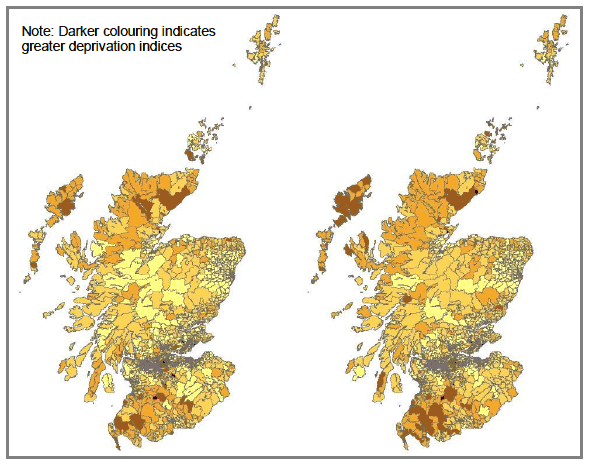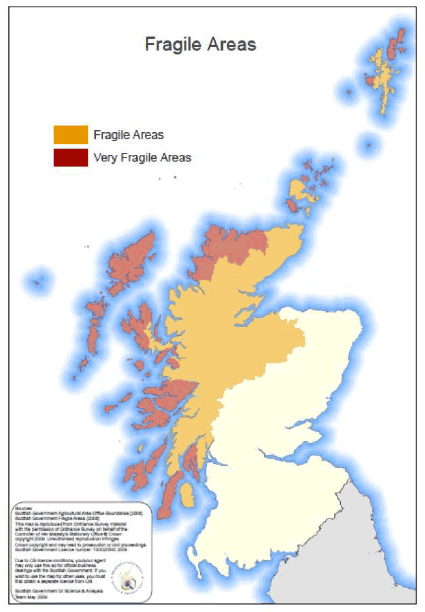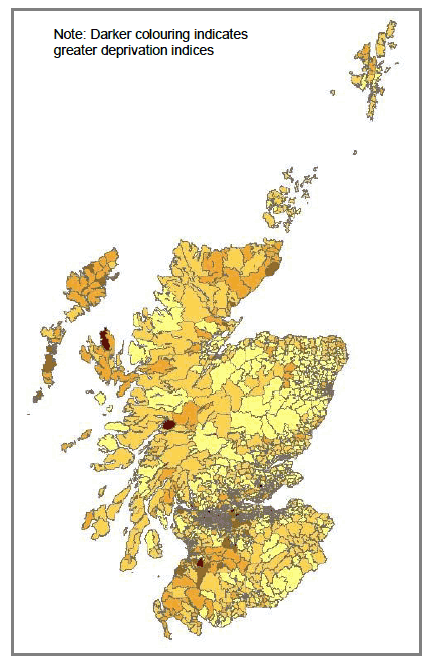Draft Sectoral Marine Plans for Offshore Renewable Energy in Scottish Waters - Environmental Report Appendix B: Baseline Information
Appendix B to the SEA Environmental Report of the Draft Sectoral Marine Plans for Offshore Renewable Energy in Scottish Waters.
This appendix contains Baseline Information.
1.3 Population and Human Health
Key Issues Summary
- There is an east - west split in the rural characteristics of coastal communities, with the islands, north and west coast typically having smaller populations coupled with greater distances to services.
- The west coast and island communities typically have a greater reliance on marine core areas as part of the local economy.
- Coastal and marine recreation opportunities can make an important contribution to human health and coastal economies.
- Risks associated with accident and mortality rates in the marine environment could alter with an increase in the number of offshore structures and vessel movements.
National Marine Baseline
Population distribution and change
1.3.1 The population of Scotland in 2011 was estimated at 5.295 million people [107] . Coastal communities (within 5 km of the coast) make up around 41% of the total population of Scotland, with 68% of the coastal population living within the 'developed coast' consisting of urban areas such as large towns and cities, and 14% living within the 'undeveloped coast' consisting of small towns and rural holds with agricultural land [108] . The 'isolated coast' is remote and sparsely populated but contains 18% of Scotland's coastal population [109] . While there are many settlements on the coast, less than 15% of its length has been developed [110] .
1.3.2 A positive sense of place is important to people living in many rural and coastal areas, and the importance of the quality of the environment raises concerns that detrimental effects on amenity could lead to decreasing populations and adversely impact on property values and businesses.
Employment and Deprivation
1.3.3 Neighbourhood statistics data for local authorities with a coastline and the Scottish Index of Multiple Deprivation ( SIMD) show that the majority of coastal communities are not included within the lowest percentiles, and appear to suffer less income and employment deprivation than the inner city and urban areas in Scotland's central belt [111] . The exceptions being clusters of urban communities in the South-West around Ayr and Irvine, in the North East around Aberdeen, in Eilean Siar and in some parts of south-west Dumfriesshire.
Figure B1.3.1: Areas in Scotland ranked according to the Education and Income Domains (darker areas show greater deprivation indices)

1.3.4 Scottish coastal communities play an important economic role, and as detailed in the regional summaries, many areas are economically successful.
1.3.5 Employment information indicates that around 1.6% of Scottish employment was in the core marine sector in 2008, and of this, some 31% of employment was in the Fishing, Fish Farming or Fish processing sectors [112] . The industries that contribute to the core marine sector include:
- Construction of water projects;
- Renting of water transport equipment;
- Fish farms;
- Fishing;
- Processing and preserving of fish and fish products;
- Sea and coastal water transport and supporting activities;
- Building and repairing of ships and boats;
- Service activities incidental to oil and gas extraction excluding surveying; and
- Extraction of crude petroleum and natural gas.
North East
1.3.6 Scottish coastal communities play an important economic role in the North East. Aberdeen and Aberdeenshire are making a transition from reliance on oil and gas, and are applying their energy sector and offshore strengths to the development of renewable and clean energy technologies. Aberdeen Harbour is important in providing support to the offshore industry and in accommodating a growing volume of freight.
1.3.7 Peterhead is the North Sea's largest white fish port, and also provides logistical support for the North Sea oil and gas industry whilst is handling an increasing number of cruise vessels. The port of Montrose provides import and export services for agricultural and oil related businesses and is a base for oil rig support vessels.
North
1.3.8 The Moray Firth area has experienced substantial growth, while Orkney and Shetland have benefitted from oil and gas related activities.
North West
1.3.9 The expansion of salmon and shellfish farming, tourism, food processing, small-scale manufacturing and service provision has contributed to growth in areas such as Skye, Mull, Arran, Wester Ross, Ardnamurchan and Mid Argyll, underlining the importance of their coastal location and character.
West and South West
1.3.10 Ayrshire and the South West are an important gateway for Scotland, with extensive coastal areas of a rural character. Coastal towns such as Ayr, Troon and Hunterston play an important role as key transport corridors in the region.
1.3.11 There are challenges for some coastal and island communities. This includes some of the more remote areas such as Eilean Siar, parts of Caithness and Sutherland and Kintyre, where there has been a continuing decline. Through the Fragile Areas Programme, Highlands and Islands Enterprise ( HIE) and local authorities are giving particular attention to the needs of the Outer Hebrides, North Skye, the outlying islands of Orkney and Shetland, the Argyll islands and the remote West mainland. Figure B1.3.2 displays the locations of more fragile areas within these parts of Scotland.
Figure B1.3.2: Highlands and Islands Enterprise Fragile Areas [113]

Marine Transport and Connectivity
1.3.12 Caledonian MacBrayne ferries carried around 5.3 million passengers in 2009, some 4% more than in 2008. Northlink Ferries carried around 309,000 passengers in 2009, equating to around 4% more than in 2008. Orkney Ferries carried 329,000 passengers in 2009, 3% more than in 2008. Shetland Islands Council services carried 637,000 passengers in 2009, an increase of 0.5% on 2008. In 2009, 1.9 million passengers were carried on ferry services between Scotland and Northern Ireland, the busiest Scottish port for this traffic being Stranraer [114] .
1.3.13 There are four international airports in Scotland with scheduled services: Edinburgh Airport, Glasgow International Airport, Aberdeen Airport and Glasgow Prestwick International Airport. Highlands and Islands Airports Limited operate eleven small airports across the Highlands, Orkney, Shetland and the Western Isles (Sumburgh, Kirkwall, Wick, Stornoway, Inverness, Benbecula, Barra, Tiree, Islay, Dundee, and Campbeltown) [115] . However, connectivity remains a key challenge facing Scotland's island communities.
Health, wellbeing and deprivation in coastal areas
1.3.14 Health SIMD [116] data displayed in Figure B1.3.3 demonstrates that coastal and island communities are mostly ranked within the top 20-100% of all areas in Scotland although there are parts of the north and the Western Isles where health conditions appear to be in or moving towards the lower percentiles.
Figure B1.3.3: Areas in Scotland ranked according to Health Domain

1.3.15 Research has identified that coastal zones are less likely to be deprived than inland areas [117] with just 6% of these areas in the East Region falling into the most deprived percentile (compared with 12% of all data zones), 0% in South West (compared with 3% of all data zones) and 11% in West Region (compared with 15% of all data zones). The North East had just 2% (compared with 15% of all data zones), the West Region just 1% (compared with 9% of all data zones), and the South West 0% (compared with 1% in all data zones).
Recreation
1.3.16 Marine and coastal recreation forms a valuable and growing industry for Scotland, and encompasses a wide range of activities. The Marine Atlas [118] and draft Regional Locational Guidance for Wind, Wave and Tidal Energy [119] provide detail on the types and extents of these activities, and these are summarised below:
- Bathing is undertaken mainly in the south-west, east, north-east and northern parts of the Scottish mainland.
- Recreational boating takes place throughout Scotland but is concentrated in the Clyde and along the West Coast, the Moray Firth, Solway Firth and the Firths of Tay and Forth. Recent developments along the East Coast, and within the Orkney and Shetland Isles, have increased the potential for cruising routes between the Caledonian Canal and the Shetlands with well-placed facilities and stopping points en route.
- Surfing is focused around the far North coast of Scotland (particularly around Thurso), the North coast from Buckie to Fraserburgh and locations down the East coast including Fife, and from North Berwick to the border. Other locations include the Kintyre peninsula, Islay, Tiree, the Western Isles (particularly the West coast of Lewis) and the North coast of Orkney.
- The most popular locations for scuba diving around Scotland are Scapa Flow, Orkney (considered to be one of the best wreck diving areas in the world) and the Voluntary Marine Reserve of St Abbs and Eyemouth off the Berwickshire coastline. The islands of the Inner Hebrides, the Firth of Forth coast, and the East coast from the north of Dundee to the Dornoch Firth contain popular diving destinations.
- The majority of sea kayaking and canoeing is undertaken close to shore, exploring interesting aspects of the coast such as sea caves, inlets and wildlife. Popular kayaking areas include the Inner Hebrides, East Grampian Coast, Firth of Clyde and Firth of Forth, with areas around Arisaig, Knoydart, Sound of Sleat, Argyll Islands, Oban to Fort William and the Clyde particularly popular locations.
- Recreational sea angling is carried out from most regions of the Scottish coastline, with a wide range of species caught depending on the region and the time of year. The highest densities of anglers are found in the more heavily populated areas of the coast around Glasgow, Clyde, Edinburgh and Fife. However, launch points are concentrated along the Argyll Coast and Islands, Solway Firth, Firth of Clyde, Firth of Tay, North Coast, and East Grampian Coast.
- Coastal and marine wildlife tourism, involving onshore activities such as bird and seal-watching, and offshore activities involving marine wildlife tourism specialist operators who provide access to areas for certain marine species ( e.g. cetaceans, dolphins, Basking sharks and seals).
Risks to Human Health
1.3.17 While there are controls on marine disposals and the designation of specific locations for disposals in the marine environment, a variety of sites have been used historically for this purpose. Historic disposal sites, used for the disposal of radioactive substances, industry waste and sewage sludge, could release potentially hazardous material which may impact upon the surrounding environment and have associated adverse impacts on human health if disturbed [120] .
1.3.18 The EC Bathing Water Directive seeks to preserve, protect and improve the quality of the environment and to protect human health [121] . Microbiological regulation and monitoring is driven by the risk to public health from pathogens in water, and bathing water quality is assessed in Scotland through the presence of total and faecal coliforms and faecal streptococci. If swallowed in sufficient quantities these can cause stomach upsets and ear infections [122] . In a similar way, the quality of shellfish water is assessed based on the presence of faecal coliforms ( i.e. E. coli. content) in shellfish flesh. Potential sources of contamination in this respect are difficult to distinguish, but improvements to these waters is currently being addressed by Scottish Water and River Basin Management Planning to improve sewage effluent treatment, reduce storm overflows and preventing animal faeces from entering the water environment [123] . These issues are considered in greater detail under the environmental topic of water.
1.3.19 Some 407 water related fatalities that occurred in marine and inland waters in the UK in 2011, excluding suicides, crimes and unrecorded incidents. Of these, 79 incidents occurred in coastal, shore or beach areas, 41 at sea, 30 in lochs, 26 in ports or harbours, with the remainder in inland areas ( i.e. baths, rivers, etc.). Excluding figures for inland areas, 38 of these incidents related to sailing or boating, 11 related to angling, 21 related to swimming, and just three to surfing activities [124] .
1.3.20 Despite Scotland's large marine areas, the high-level of use of the marine environment has proven to be potentially hazardous. Marine Accident Investigation Branch ( MAIB) incident report figures indicate that a total of five collisions [125] and 10 groundings [126] have been reported for all vessels in Scottish waters since 2005, largely occurring in the Inner Hebridean Isles, Aberdeen Harbour and the Firth of Clyde. Of these, four collisions and eight groundings involved merchant vessels, one of each involved ferries, and one grounding involved a leisure craft.
1.3.21 There were seven fatalities on UK-registered merchant and fishing vessels and five fatalities on leisure craft in Scottish waters in 2011. While a further eight fatalities were recorded on foreign-registered dry-cargo vessels in UK waters in 2011, it is not known if any occurred within Scottish waters as there is currently no requirement for non- UK flagged vessels to report accidents outside of ports and harbours to the MAIB [127] .
1.3.22 A study of shipping routes and the potential for collision was undertaken as part of the SEA of Marine Renewables [128] . The study used recorded automatic identification system ( AIS) data undertaken over a two-week span in January 2006 [129] , and concluded that close quarter events (described as vessels travelling within 500m range of one another) are a common occurrence between vessels in Scottish waters, particularly along narrow waterways and near to or on approach to ports and harbours. Most of these occurrences involved vessels on common routes, vessels running beside one another, or tug or pilot boats near to port. None were classified as a 'near miss' or a potential collision.
Contact
There is a problem
Thanks for your feedback